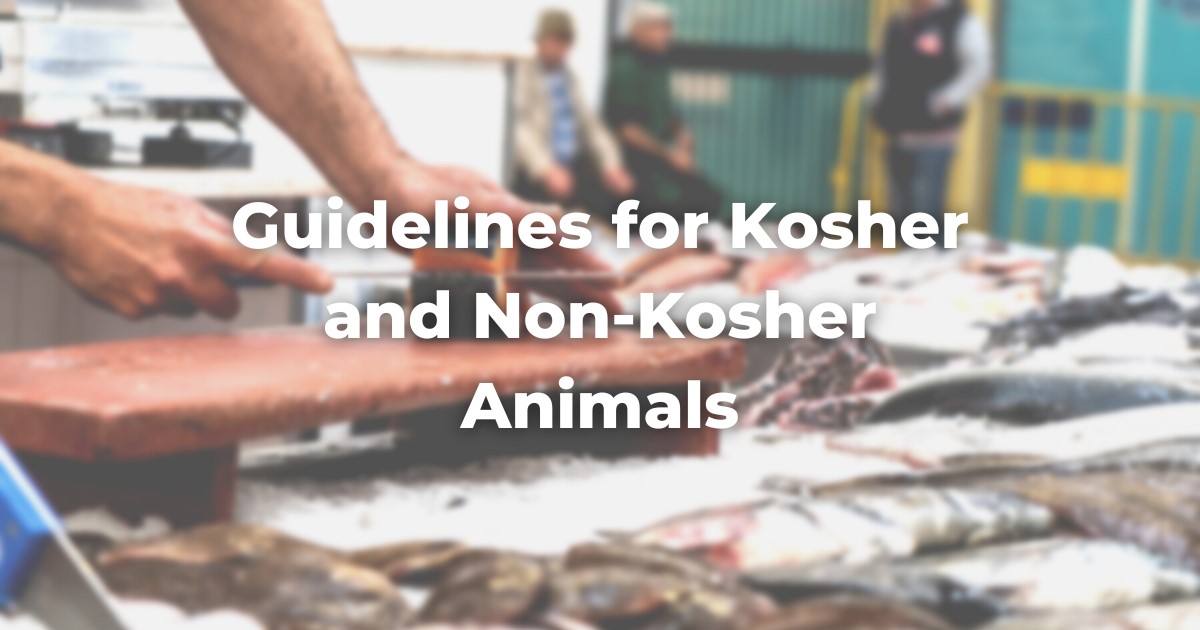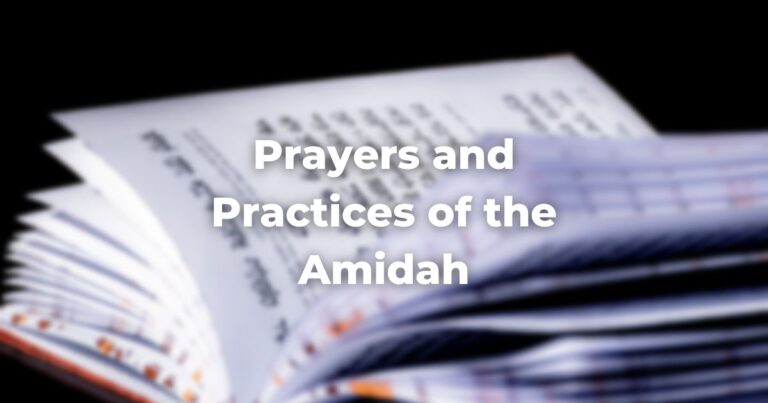Which animals are kosher?
The most basic rules of kashrut (keeping kosher) are presented in the TorahRefers to the first five books of the Hebrew Bible, the Tanakh, also called the Five Books of Moses, Pentateuch or the Hebrew equivalent, Humash. This is also called the Written Torah. The term may also refer to teachings that expound on Jewish tradition. Read more, primarily in the eleventh chapter of Leviticus and the fourteenth chapter of Deuteronomy.
Simply put, the Torah declares that certain animals may be eaten (after they have been slaughtered, inspected, and prepared appropriately) and others not.
Table of Contents
Land Animals
The rule for land animals is a simple one: kosher animals must both chew their cud and have split hooves (Leviticus 11:3 and Deuteronomy 14:6).
Therefore, the animal species that can be kosher include cows, oxen, goats, sheep, buffalo, and deer. The concept of chewing the cud may be unfamiliar to urban moderns, but it is really a simple matter.
Certain animals, called ruminants, have a series of stomach chambers instead of the single stomach human beings have. Once food is eaten, only some of it is immediately digested, while another part, the cud, is then regurgitated and rechewed until it is reswallowed and then digested.
Why such land animals were considered acceptable as food but not others is never explained in the Torah. (It will simply have to remain a topic for moderns to chew over!)
As a result, land animals that present split hooves but do not chew their cud can never be kosher, no matter how they are slaughtered.
The best known example of this is surely the pig, which has split hooves but does not chew its cud.
Both signs are required in order to be kosher—there is no category of “partially kosher” animals.
Fish
A fish can be kosher animals if it has both scales and fins (Leviticus 11:9 and Deuteronomy 14:9).
Sharks, whales, and dolphins are thus all excluded, as are octopuses, squid, and similar sea animals. Catfish, because they lack scales, may not be eaten.
Also excluded are sea creatures referred to under the general rubric of “seafood,” such as crab, lobster, shrimp, oyster, and eel.
The most common fish species that are not kosher are blowfish, catfish, dogfish, eel, eelpout, ocean pout, puffer, and shark.
There are, of course, many varieties of fish having scales and fins which may be eaten, so there is always a plentiful selection available.
Popular kosher fish include albacore, anchovies, carp, cod, flounder, haddock, halibut, herring, mackerel, muskellunge (muskie), perch, pike, pollock, red snapper, salmon, sardine, sea bass, smelt, sole, striped bass, tilapia, trout, tuna, and whitefish.
(The lists here are not to be considered exhaustive; in cases of uncertainty, a competent rabbi should be consulted.) Caviar, like any kind of roe, is kosher only when the fish from which it comes is kosher.
One of the areas in which Conservative and Orthodox authorities differ has to do with the kashrut of swordfish and sturgeon.
After researching the details of rabbinic law and working with ichthyologists, Conservative scholars determined that swordfish and sturgeon may be considered kosher (Klein, p. 305).
It is precisely because of the great variety of both kosher and non-kosher fish that consumers must be careful when purchasing fish.
The names of many fish varieties, kosher and non-kosher, are often similar. Mahi-mahi, for example, often marketed as “dolphin fish,” is kosher, but real dolphins are not, and similar situations can cause confusion.
Therefore, when choosing fish for meals, it is important to be careful to purchase only kosher species.
Aside from the issue of confusing names and unknown varieties, there are two related factors that make it especially important to exercise great care when purchasing fileted fish.
When set out on a fishmonger’s table, the skinned filet of a kosher fish and that of a non-kosher fish are more or less impossible to tell apart, even for an expert.
Therefore, buying fish prepared under kosher supervision is by far the best way to be sure the fish purchased is truly kosher.
The second issue has to do with the equipment on which the fish is prepared.
Under normal circumstances, consumers should always assume there is only one set of knives, cutting boards, and other utensils used for preparing the fish offered for sale.
As such, it is reasonable to assume that the same knives used to filet non-kosher fish or seafood are going to be used to prepare the kosher fish as well. Although washing and sharpening the knife between non-kosher and kosher fish may be sufficient to permit the use of the fish (Shulchan Arukh, Yoreh Deah 121:7), the preference remains to purchase fish from a kosher supervised source.
There is an ancient custom dating back as far as the days of the TalmudReferring to one of two collections, the Jerusalem and Babylonian Talmuds, edited in the 6th century, that contains hundreds of years of commentary, discussion, and exploration of the ideas in the Mishnah. One could describe it as Mishnah + Gemara = Talmud Read more not to eat meat and fish on the same plate.
This notion is based on some putative danger involved in eating them together, however, not on any actual concern related to kashrut (see, e.g., Shulchan Arukh, Yoreh Deah 116:2). In 1998, the Committee on Jewish Law and Standards determined that meat and fish may be eaten together (See CJLS Responsa On Mixing Meat and Fish).
In the précis of the decision, the following explanation is offered: “The prohibition of fish and meat is based on a specific danger to the consumer. Historically when the danger ceased to exist, the rabbis had the power to end the prohibition. Today we know that there is no danger caused by eating fish and meat together. Therefore, we would permit not only putting fish and meat on the same plate, but would allow them to be consumed together.”
Birds and Fowl
Unlike the specific descriptions Scripture offers regarding the traits of kosher mammals and fish, the Torah offers no specific traits by means of which to determine the kashrut of birds.
Instead, the Torah contents itself simply to present lists of prohibited birds at Leviticus 11:13–19 and Deuteronomy 14:11–18. Nevertheless, over the years, rabbinic authorities have established certain rules of thumb to aid the consumer in determining whether a bird is likely kosher or not.
Generally speaking, a careful inspection of the lists yields the principle that birds of prey are not kosher, while birds that live off grains and grasses usually are.
This principle notwithstanding, it is the lists of birds in the Torah which are considered authoritative, not the latter principle. Therefore, birds of prey not on the Torah’s list are not necessarily deemed unkosher.
Since, however, the rules of kosher slaughter (discussed below) do apply to fowl, the only rational way to be sure that fowl is kosher is to purchase it from a shop under reliable kashrut supervision.
One of the great dilemmas of kashrut legislation has traditionally rested in determining which birds are the ones mentioned in the Torah. (Many of the names are unique to these lists and have never been identified with any real certainty.)
There are also some families that have maintained unique, entirely idiosyncratic traditions about specific modern-day birds, identifying them with birds on the Torah’s list of forbidden fowl. (One such tradition, for example, considers turkey to be unacceptable, identifying it as the biblical bird dukhifat mentioned at Leviticus 11:19 and Deuteronomy 14:18.)
Generally speaking, individuals should maintain the customs of their own ancestors, but there is no need for others to do so. All halakhic authorities today, for example, consider turkey to be a kosher bird.
Insects
Although the Torah says clearly at Leviticus 11:22 that some insects are kosher, it is today generally considered impossible to identify these insects correctly.
As a result, therefore, today the practice is to consider all insects to be forbidden.
If the food into which an insect falls is uncooked—if, for example, a beetle falls into a bag of flour or sugar—the beetle can simply be removed and the food used. (Whether this is a good idea from a hygienic point of view is another issue.)
Although the general rule in cases of the inadvertent mixture of prohibited and kosher foods is that the mixture itself is permitted if the kosher foodstuff is more than sixty times greater in volume than the non-kosher item (according to the rule known as bateil b’shishim), that rule does not apply in the case of an entire creature like the beetle mentioned above.
Therefore, if a whole insect falls from a bag of noodles into a pot of soup and is cooked with the noodles, the insect is not considered annulled regardless of the volume of the soup. The soup cannot be used in such a case and the pot must be kashered by boiling.
(The term kashering is widely used to denote the process of making non-kosher kitchenware of various sorts kosher. The variant koshering is also in use.)
Of course, the prohibition of eating insects requires diligence when washing vegetables so as to assure that any minuscule insects present are rinsed away. Once vegetables appear clean to the naked eye, they are permitted (Arukh Hashulchan, Yoreh De’ah 84:36).
Questions about insects or small crustaceans found in water have been raised in many communities over the past few years. The rule noted above, that kashrut concerns end with what can be seen by the naked eye, applies here as well.
One need be concerned about the kashrut of the water (not to mention health issues and aesthetics) only if insects or other minute organisms can actually be seen swimming or floating around in a glass of tap water (Shulchan Arukh, Yoreh Deah 84:1).
If we were to avoid all potentially prohibited microscopic organisms, we would not be able to eat, drink, or even breathe.
Adapted with permission from The Observant Life.
Authors
-

Rabbi Paul S. Drazen (1951-2018) spent two-thirds of his rabbinic career serving individual congregations and one-third on the staff of USCJ, all the while creating programs and educational opportunities to make Jewish observance and practice clear, accessible, and attainable for everyone.
View all posts -

The Observant Life: The Wisdom of Conservative Judaism for Contemporary Jews distills a century of thoughtful inquiry into the most profound of all Jewish questions: how to suffuse life with timeless values, how to remain loyal to the covenant that binds the Jewish people and the God of Israel, and how to embrace the law while retaining an abiding sense of fidelity to one’s own moral path in life. Written in a multiplicity of voices inspired by a common vision, the authors of The Observant Life explain what it means in the ultimate sense to live a Jewish life, and to live it honestly, morally, and purposefully. The work is a comprehensive guide to life in the 21st Century. Chapters on Jewish rituals including prayer, holiday, life cycle events and Jewish ethics such as citizenship, slander, taxes, wills, the courts, the work place and so much more.
View all posts







